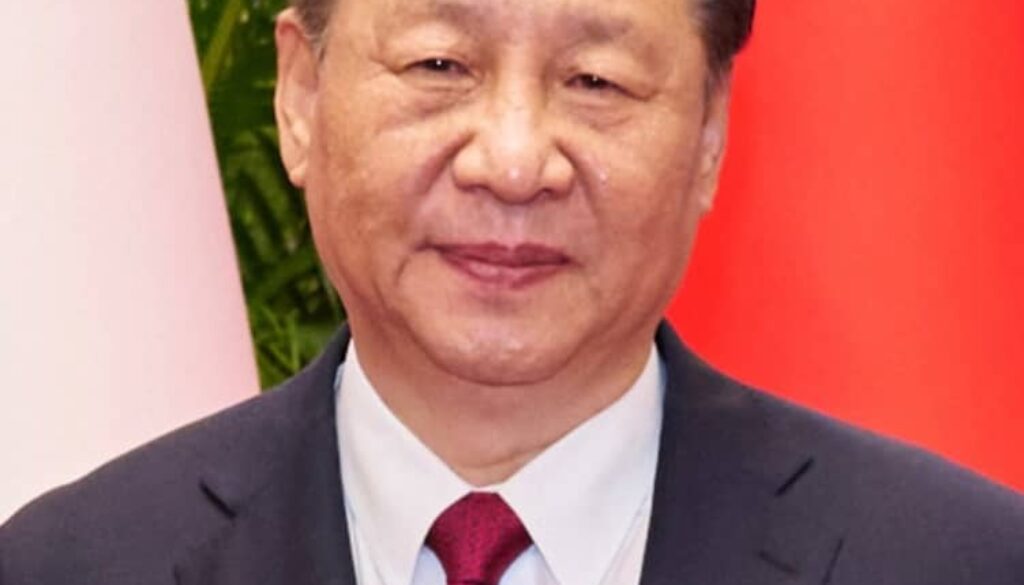CHINA’S BRI INITIATIVE CONTINUES TO YIELD DIVIDENDS IN THE WORLD
BY KINGSLEY E.HOPE
On October 10, 2023, China marked the 10th anniversary of the launch of its ambitious Belt and Road Initiative (BRI) with the unveiling of a ‘White Paper’ on the BRI.

The document, titled, “The Belt and Road Initiative: A Key Pillar of the Global Community of Shared Future,” represents an overarching review and reaffirmation of the BRI’s global role and impact since its conception and launch in 2013.
It initially took the form of the “One Belt, One Road initiative,” and encompassed the overland Silk Road Economic Belt and the Maritime Silk Road. These two components gave birth to an interconnected network of trade routes spanning continents.
In 2016, a significant change occurred when the initiative’s name shifted to the Belt and Road Initiative, better representing its broad scope and global outlook.

President Xi Jinping
In the following year, the BRI was elevated to a national vision and strategy, emphasizing its pivotal role in China’s long-term development and global engagement.
Although the BRI was initially conceived to enhance connectivity between East Asia and Europe (the Eurasian continent) through a comprehensive network of road and maritime infrastructure, it has since expanded beyond the Eurasian continent and reached Africa and Latin America.
As a result, it has developed into a far-reaching global initiative, with over 150 countries and 30 international organizations participating through joining or signing cooperation agreements with the BRI.
Since the launch, the project has significantly impacted African countries.
With 53 African nations participating, the BRI has contributed substantial investments in infrastructure, including ports, railways, and renewable energy projects.
It is on record that in 2023, African countries received $21.7 billion in BRI deals, thus making China a giant lender in Africa, with loans exceeding $170 billion to 49 African countries and regional institutions from 2000-2022.
The initiative has led to the construction of critical infrastructure such as roads, railways, ports, and power facilities which is transforming the continent’s economic landscape.
Notable examples of these projects include the Mombasa-Nairobi Railway in Kenya, the Addis Ababa-Djibouti Railway in Ethiopia, the Port of Doraleh in Djibouti, the Maputo-Katembe Bridge in Mozambique, the Lagos-Kano Railway in Nigeria, the Entebbe-Kampala Expressway in Uganda, the Cherchell Ring Expressway and Port in Algeria, among others.
These endeavours exemplify the tangible impact of the BRI on Africa’s journey towards realizing its development goals and Agenda 2063, which outlines a significant connection between the BRI and regional and global development initiatives.
Specifically, the BRI aligns with plans such as the African Union’s (AU) Agenda 2063 and the United Nations 2030 Agenda for Sustainable Development.
This alignment implies that the implementation of the BRI complements the development objectives of Africa.
Adopted by the AU in 2015, Agenda 2063 is a comprehensive, long-term development framework to transform the continent into a global powerhouse.
This vision entails a peaceful, prosperous, and integrated continent, emphasizing innovative and flagship projects to foster integration among African nations.
The projects include the development of a modernized and integrative infrastructure network to facilitate the free movement of goods and people and the establishment of an African Free Trade Area to promote intra-regional trade.
The latter objective has been successfully realized by establishing the Africa Continental Free Trade Agreement (AfCFTA), the world’s largest free trade area, which is mandated to create a single continental market for the African people.
During the 2018 Forum on China-Africa Cooperation (FOCAC) summit in Beijing, which marked the largest ever meeting between Chinese and African leaders, a very significant declaration was made.
China and African nations agreed to deepen their cooperation by aligning Africa’s Agenda 2063 development strategies with the BRI, which aimed to enhance connectivity in various areas, including policy, infrastructure, trade, finance, and industrial capacity under the BRI.
According to the “Governance of China” book, by President Xi Jinping, on building a closer belt and road partnership, “the BRI is a public road open to all,not a private path owned by one single party…all interested countries are welcome to take part in cooperation and share in its benefits”.
President Xi Jinping, on April 20,2021 at the opening ceremony of the Boao Forum for Asia Annual Conference, via video link, stated “going forward, we will continue to work with other parties on high quality belt and road cooperation…we will follow the principles of extensive consultation, joint contribution and shared benefits…we will ensure that belt and road cooperation is people-centered and sustainable,and meets high standards”.
A World Bank study suggests that by 2030,belt and road projects wil have helped to lift about 7.6 million people from extreme poverty and 32 million people from moderate poverty across the world.
As of June 2023, the China-Europe Railway Express has achieved an extensive network, encompassing over 200 cities in 25 European countries.
This network spans 86 routes that traverse vital regions within the Eurasian hinterlands, signifying the remarkable reach and impact of the BRI on intercontinental trade and connectivity.
Other substantial infrastructure projects under the umbrella of the BRI include, the China-Laos Railway, the Jakarta-Bandung High-Speed Railway, the Belgrade-Novi Sad section of the Hungary-Serbia Railway, the China-Kyrgyzstan-Uzbekistan Highway, the China-Central Asia Gas Pipeline, and the development of the Port of Piraeus in Greece.
Acting in the spirit of openness and inclusiveness, President Xi Jinping continued, “we will work with all BRI participants of the belt and road into a pathway to poverty reduction and economic growth and contribute to common prosperity for all”.
2.China’s Global Cooperation in Poverty Reduction and Green Development: A New Era of Sustainable Development.
Undoubtedly,China has emerged as a leader in global cooperation, particularly in poverty reduction and green development.
In fact, the country’s remarkable progress in lifting over 750 million people out of poverty some four decades ago, has become a topical issue which has inspired nations worldwide.
The country’s Global Development Initiative (GDI), proposed by President Xi Jinping in 2021, aims to accelerate the implementation of the United Nations’ 2030 Agenda for Sustainable Development.
The commitment of China to sustainable development, prioritizes green growth, innovation, and international cooperation.
The GDI focuses on eight key areas, including poverty reduction, food security, pandemic response, financing for development, climate change, green development, industrialization.
Talk about China’s poverty alleviation,the strategy focuses on rural development, investing in rural infrastructure, education, and healthcare.
On economic empowerment, it has been providing training, microfinance, and job opportunities, while its social welfare aspect is ensuring access to basic services, such as healthcare and social security.
To create eco-friendly infrastructure,the project has been developing sustainable transportation systems and green buildings, ensuring environmental conservation, by way of protecting biodiversity, forests, and water resources.
The GDI has made significant strides in Africa, fostering cooperation and development across the continent.
We can look at some examples of African nations that have benefited from China’s broader development initiatives.
Key among the beneficiaries are:
South Africa, a key partner of the BRI, which has seen significant investments in infrastructure development, including transportation and energy projects.
Egypt has also benefited heavily in terms of infrastructure, including the construction of the Suez Canal Economic Zone and various transportation projects.
Nigeria cannot be ruled out as China has provided significant financial support to their infrastructure development, including rail and road projects.
In Kenya, China has invested in transportation infrastructure, including the construction of the Mombasa-Nairobi Standard Gauge Railway.
Ethiopia has been supported in their industrialization efforts, including the development of industrial parks and manufacturing facilities.
Indeed, the GDI has been promoted through the Belt and Road Initiative (BRI), which was launched a decade ago by President Xi Jinping aiming to create a vast network of economic corridors, fostering global trade, investment, and cooperation, with China at its center.
In his ‘Governance of China’ book, on shared humanity President Xi Jinping said “there is only one earth and we humans have only one home…earth is still the only home we have so to care for and cherish it is our only option…we should not only think about our own generation, but also to take responsibility for those to come”.
According to President Xi Jinping “China stands for building a community of shared future for mankind and achieving inclusive and win-win development”.
To press home their effort to ensure development for all in the world, he continued “China has benefited from the world in its development, and China has also contributed to the world’s development;
“We will continue to pursue a mutually beneficial opening-up strategy, share our development opportunities with other countries and welcome them on board the train of China’s development”.
The above quotes provide insight into President Xi Jinping’s vision for China’s development and governance, emphasizing the importance of participation, international cooperation, and sustainable growth.
The quotes sum up the simple reason China is sharing its expertise and investing in green infrastructure, as well, and demonstrating its commitment to a more equitable and sustainable world.
As the global community continues to address pressing development challenges, China’s leadership and cooperation is very crucial in achieving the United Nations’ Sustainable Development Goals.
China has been actively engaged in global cooperation efforts to reduce poverty and promote green development and that has been strengthened through
established partnerships with various international organizations, including the United Nations, to support global development cooperation.
The collaboration with the United Nations also gears toward Sustainable Development Goals (SDGs) and climate change initiatives.
There has been collaboration with the Asian Infrastructure Investment Bank (AIIB), to finance sustainable infrastructure projects, as well as partnership with Brazil, Russia, India, and South Africa on development and climate issues.
China,on climate change and green development, has committed to reducing its carbon footprint and promoting sustainable development.
The country has also launched the Global Development and South-South Cooperation Fund with a total input of $4 billion. Additionally, China has pledged to increase its contribution to the UN Peace and Development Trust Fund.






